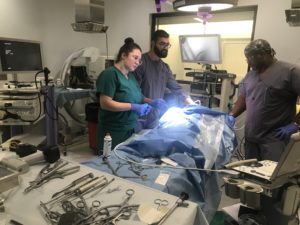When placing central and arterial lines using ultrasound imaging, it can be very difficult for clinicians to maintain a sterile field and keep the transducer steady while examining the image on the other side of the room. What if the ultrasound image could be projected onto the patient’s procedure site itself?
Georgia Tech Biomedical Engineering students Robert Bridenhagen, Gabriel Cruz, and Annika Clawson teamed up with Computer Engineering student Matthew Aspinwall and Electrical Engineering student Matthew Zilvetti to form the interdisciplinary team S.A.V.A.G.E.
“Since we have a combination of biomedical, electrical and computer engineers in our team, we were looking for a project that would include a significant, innovative electronic component – in this case imaging – to a medical device opportunity in need of improvement,” Clawson said.
The team combined their areas of knowledge, interests and study to develop a device that aids in the placement of ultrasound-guided arterial and venous lines.
“This is a very common procedure to have done, especially if you’re in extended stay care or hospice, with over 5 million central venous catheters being placed in the U.S. every year,” said Clawson.
“Currently, doctors are looking at the ultrasound base station that’s across the room while holding a probe in one hand and trying to place a needle with the other,” Bridenhagen explained. “It takes the focus away from the procedure site and puts it on the base station. Because of this, doctors can puncture a lung or carotid artery and those kinds of complications can cause a lot of extra surgery and extra time in the hospital.”
“Our device puts the image of the base station on the procedure site so the doctor can look at the needle and the procedure site simultaneously, reducing the number of punctures.”
Putting their vision to the test in a real OR
 GCMI was pleased to provide several of the biomedical engineering Capstone teams, including S.A.V.A.G.E., with full access to the OR at our preclinical facility so that they could test their device prototype in a cadaveric model. These facilities are regularly used by medtech innovators for the testing of novel devices or by medical professionals for bioskills training.
GCMI was pleased to provide several of the biomedical engineering Capstone teams, including S.A.V.A.G.E., with full access to the OR at our preclinical facility so that they could test their device prototype in a cadaveric model. These facilities are regularly used by medtech innovators for the testing of novel devices or by medical professionals for bioskills training.
“We wanted an opportunity to be able to envision what our device would look like in the problem space,” Clawson added. “Being able to see it ‘in action’ was extremely valuable.”
